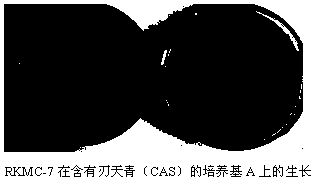Enterobacter agglomerans with phosphate-solubilizing capacity, and application thereof
A technology of Enterobacter agglomerans and Enterobacter agglomerates, which is applied in the fields of application, bacteria, seeds and rhizome treatment, etc., can solve the problems of unsatisfactory pollution remediation, weak growth mitigation phosphorus ability, etc., and achieve environmental friendly cost, promote growth, high The effect of phosphorus solubilizing ability
- Summary
- Abstract
- Description
- Claims
- Application Information
AI Technical Summary
Problems solved by technology
Method used
Image
Examples
Embodiment 1
[0055] Example 1: According to the method for mutagenesis and breeding of Enterobacter agglomerans with phosphorus-solubilizing ability provided by the present invention, mutagenesis screening can tolerate the strong mutagenized strain of heavy metal lead phosphorus-solubilizing ability, comprising the following steps:
[0056] 1) Enterobacter agglomerans KMC with high phosphorus-solubilizing ability screened from the plant rhizosphere in the laboratory was used as the starting strain;
[0057] 2) Mutation breeding
[0058] (1) Prepare the single-cell suspension of the starting strain KMC
[0059] The starting strain KMC was inoculated in liquid medium A, cultured at 28°C, 150rpm for 12hrs, centrifuged, washed with sterile physiological saline, placed in a Erlenmeyer flask equipped with glass beads, and oscillated to disperse into a single-cell bacterial suspension liquid;
[0060] The composition of the medium A is: tryptone 5 g, yeast powder 5 g, NaCl 10 g, distilled wat...
Embodiment 2
[0070] Example 2: RKMC-7 on Pb 2+ resistance, the determination steps are as follows:
[0071] Inoculate RKMC-7 in liquid medium A for enrichment culture, grow to exponential phase, centrifuge at 8000 rpm for 10 min, wash with 0.85% sterile NaCl solution three times, then adjust the bacterial solution with 0.85% sterile NaCl solution Concentration is 10 7 CFU / ml, draw 1 mL and add 80 mL of Pb with different concentrations 2+ ( 0, 400, 800, 1000, 1200mg Pb 2+ / l ) in a 250 mL Erlenmeyer flask of liquid medium D, Pb2+ With Pb(NO 3 ) 2 After adding in the form of 28 ° C for 5 days, the absorbance value of the culture solution was measured at 600 nm. The results showed that: in Pb 2+ When the concentration reaches 1000mg / L, RKMC-7 can still grow, indicating that RKMC-7 can tolerate higher concentrations of Pb 2+ , can grow in heavily polluted Pb-contaminated soils, and has the potential to remediate Pb-contaminated soils. RKMC-7 anti-Pb 2+ The growth chart is attached...
Embodiment 3
[0072] Example 3: RKMC-7 stability determination, the specific steps are as follows:
[0073] Quickly thaw the frozen RKMC-7 at 37°C, put 1% of the inoculum into a test tube containing 10ml of liquid medium A, culture at 28°C for 12hrs, centrifuge, and use 0.85% sterile After washing with NaCl solution for three times, suspend with 0.85% sterile NaCl solution, and adjust the cell concentration to 1×10 7 CFU / ml, insert in liquid medium B according to the inoculum size of 2%, cultivate 7 days at 150rpm, measure the content of soluble phosphorus in the supernatant with molybdenum blue colorimetry; 1% of the inoculum was then transferred to fresh liquid medium A, and the above steps were repeated for a total of 14 passages to determine the phosphorus-dissolving ability of RKMC-7. The results are shown in the attached Figure 6 , it can be seen from the figure that after 14 passages, the phosphorus-dissolving ability of RKMC-7 remained basically stable, which indicated that the ...
PUM
| Property | Measurement | Unit |
|---|---|---|
| temperature | aaaaa | aaaaa |
Abstract
Description
Claims
Application Information
 Login to View More
Login to View More - R&D
- Intellectual Property
- Life Sciences
- Materials
- Tech Scout
- Unparalleled Data Quality
- Higher Quality Content
- 60% Fewer Hallucinations
Browse by: Latest US Patents, China's latest patents, Technical Efficacy Thesaurus, Application Domain, Technology Topic, Popular Technical Reports.
© 2025 PatSnap. All rights reserved.Legal|Privacy policy|Modern Slavery Act Transparency Statement|Sitemap|About US| Contact US: help@patsnap.com



